On the afternoon of 1st February 1945 the crew of this 433 Squadron aircraft took off from Skipton on Swale airfield at 15.23hrs to undertake an operational flight to bomb Ludwigshafen. They bombed the target area at 19.28hrs but while over the target the aircraft was hit by flak which damaged the front turret. The pilot took evasive action and no further damage occurred. During the course of the flight the aircraft's navigation equipment failed and after asking for radio assistance they were able to make the return flight to the skies over Yorkshire. The weather they then experienced as they approached their base was poor, the aircraft flew through strato cumulus cloud which resulted in the aircraft encountering severe turbulance. The aircraft lost and then gained height and airspeed a few times in quick succession resulting in everyone in the aircraft who was not strapped being thrown about. The aircraft was flying at around 3,000 feet when the pilot ordered his crew to abandon the aircraft probably fearing he was loosing control, two of the crew made good their escape and landed safely. Before anyone else could get clear the aircraft crashed at 23.20hrs into a field near Throstle Nest Farm, between Asenby and Cundall, to the north east of Dishforth. The remaining five members of the crew died as a result of the accident.
The pilot was six operational flights into his second Tour (his first Tour was with 102 Squadron and then the first five of his second Tour were made with 426 Squadron). The other members of the crew had all made over twenty operational flights in their first Tour. This accident was the first 433 Squadron Lancaster to be written off since conversion from Halifaxes. In documenting this incident I have drawn the crew list and basic details from William Chorley's superb series of Bomber Command losses books, however in the case of this incident there is a rare but major error. The book states that this aircraft crashed near Driffield, not Dishforth which is clearly a case of mind block when he typed the proof rather than poor research as all the contemporary documentation relating to the incident states Dishforth.
Pilot - S/Ldr Harold Keith Stinson DFC RCAF (J/8418), aged 23, of Lindsay, Ontario, Canada. Buried Harrogate Stonefall Cemetery, Yorkshire (H/F/10).
Flight Engineer - P/O Edward Henry Thompson RAFVR (187130), aged 20, of West Hampstead. Buried Hampstead Cemetery, London.
Navigator - F/O Donald James McMillan RCAF (J/35716), aged 23, of Orangeville, Ontario, Canada. Buried Harrogate Stonefall Cemetery, Yorkshire (H/F/9).
Wireless Operator / Air Gunner - P/O John Thomas McShane RCAF (J/89146), aged 25, of Kamloops, British Columbia, Canada. Buried Harrogate Stonefall Cemetery, Yorkshire (H/F/8).
Mid Upper Gunner - P/O Roy Pierson RCAF (J/92192), aged 21, of Taber, Alberta, Canada. Buried Harrogate Stonefall Cemetery, Yorkshire (H/F/7).
Bomb Aimer - F/O Anthony William Bellos RCAF (J/35586). Uninjured.
Rear Gunner - P/O Robert James Thompson RCAF (J/90641). Uninjured.
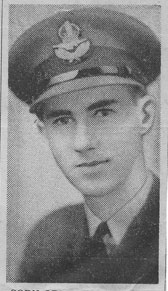
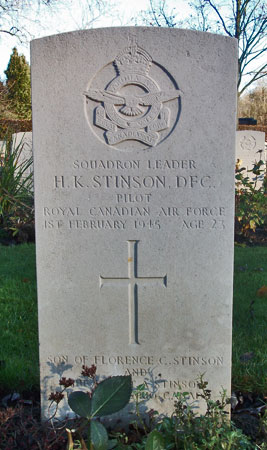
Harold Stinson was born on 13th January 1922 at Janetville, Ontario, Canada and was the son of Thomas Albert and Florence Clara (nee English) Stinson. His father died in 1929 and the family would later move to Lindsay, Ontario. After attending high school Harold studied at the Radio College of Canada and was still attending when he enlisted for RCAF service on 7th November 1940 in Toronto. He had initially enlisted for ground duties to serve as a ground wireless operator but would remuster as aircrew around May 1941 and receive pilot training (possibly after receiving air wireless operator training). Following basic pilot training he was awarded his Pilots' Wings and was also granted a commission on 24th October 1941. He arrived in the UK the following month and after further training at 10 OTU was posted to 102 Squadron on 18th June 1942. He flew two operational flights as a second pilot (on 13th and 19th July 1942) to gain operational experience and then flew his first as captain on 21st July 1942. On 2nd September 1942 he was returning from an operational flight in Halifax W1248 with a failed engine, due to an error by his then flight engineer the fuel supply to the other three engines cut off resulting in all the engines failing. The aircraft lost height and being unable to reach an airfield he made a forced landing in a field near Low Catton, east of York. None of his then crew were injured. He continued his Tour with 102 Squadron and would be awarded the DFC, Gazetted on 14th May 1943, with the citation stating "his officer has completed a large number of operational sorties on important targets such as Berlin, Kiel, Essen and on Genoa and Turin. These attacks have been completed with consistent skill. On several occasions this captain has encountered severe opposition from anti-aircraft fire and enemy fighters. Flight Lieutenant Stinson is an exceedingly capable officer who can be relied upon to complete his allotted task with efficiency." The battle damage sustained occurred on 29th July 1942, 23rd September 1942 and 22nd November 1942. Following a Tour with 102 Squadron he was posted award to instruct at 1659 HCU, beginning with a course at No.3 Flying Instructor School he then served at 1659 HCU from April 1943 until August 1944. In August 1944 he was granted special leave in Canada and returned home but probably on the knowing that he would then be posted operational again when he returned to the UK six weeks later. On his return he was posted to 426 Squadron on 2nd December 1944 and then to 433 Squadron on 12th December 1944. It would be worth pointing out that he was vastly experienced on flying the Halifax type but had little experience on flying Lancasters. The flight ending in the crash of Lancaster NG460 was not only his first operational flight in a Lancaster but his first night-flight in a Lancaster and with little Lancaster instrument flying experience to his name.
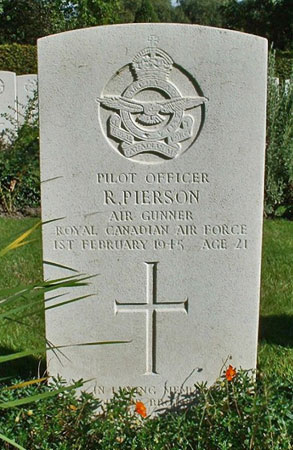
Roy Pierson was born on 6th March 1923 at Taber, Alberta, Canada and was the son of Harmon Dudley and Annie Marie (nee Longberg) Pierson. Both his parents were born in the USA, his father died in 1928 while his mother died in 1941. Roy was from a large family with many older brothers and sisters. After finishing school in 1938 he began working in farming locally. He enlisted for RCAF service in Alberta on 4th February 1943 for aircrew duties and following training he was awarded his air gunners' flying badge on 24th November 1943. On arrival in the UK in early 1944 he trained at 22 OTU and 1659 HCU before posting to 426 Squadron on 13th July 1944. He was granted a commission on 11th October 1944 and was posted to 433 Squadron on 12th December 1944.
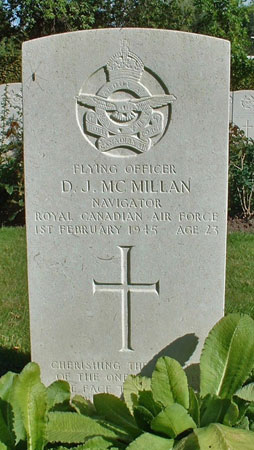
Donald McMillan was born on 10th October 1921 at Orangeville, Ontario, Canada and was the son of James Armour and Edith (nee Phair) McMillan. After finishing high school in Orangeville in 1940 he began working as a mechanic with his father at the family garage. He enlisted for RCAF service on 20th August 1842 in London, Ontario and after training in Canada he was awarded his air navigators' flying badge and also a commission on 17th September 1943. He would marry local girl Beatrice Black at Orangeville while mid way through training and he and his wife had a baby girl, born in March 1944, whom he would never meet. He had been posted overseas in October 1943 and further trained at 6 (O)AFU, 23 OTU and 1659 HCU before posting to 426 Squadron on 13th July 1944. He served with 426 Squadron until being posted to 433 Squadron on 12th December 1944.
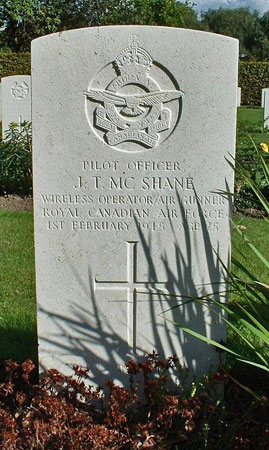
John McShane was born on 5th November 1919 in Vancouver, British Columbia, Canada and was the son of Robert Martin and Orpha Evelyn (nee Dolan) McShane. After leaving school he he worked as an apprentice mechanic for the Ford Motor Company of Canada for a couple of years but left to become a telegrapher operator with the Canadian Pacific Railway. In 1941 he enlisted into the Canadian Army. He married Ivy Parkin in June 1941 and they would go on to have two sons, the youngest he too would never meet. He enlisted for RCAF service in Vancouver on 11th November 1942 and after training in Canada was awarded his wireless operators' flying badge on 1st October 1943 with the air gunnery part of the flying badge being complete the following month. He was posted overseas in December 1943 and continued his training in the UK with 3 (O)AFU, 22 OTU and 1659 HCU. He too was posted to 426 Squadron on 13th July 1944 and to 433 Squadron on 12th December 1944. He had received a commission on 9th August 1944.
Edward Thompson received a commission to the rank of P/O on probation on 11th October 1944.
Anthony Bellos was born on 29th July 1916 in South Fort George, He enlisted for RCAF service in 1941 and while serving in the UK he married Patricia Bassett in Middlesex before returning to Canada after the War as a couple. He died in December 2013 in Kamloops, British Columbia.